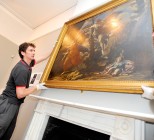Museums, galleries, National Trust properties and other heritage sites across Britain are being urged to think about how to keep their treasured art and artefacts safe as Scotland and the north of England continue to battle unprecedented floods.
Record rainfall in December has left areas in Yorkshire, Lancashire and Cumbria – and huge swathes of Scotland – battling against high water levels.
There is more rain and snow forecast this month and for city centre museums and galleries – and just as importantly for more isolated rural estates – this presents a huge challenge.
Many museums in Cumbria and Lancashire had to close in December and even those which escaped serious flooding found that humidity levels were a problem.
Keeping priceless museum artefacts and works of art safe in times of freak weather takes careful planning and management according to Crown Fine Art, a company that provides secure transportation, storage, installation and de-installation services for the world’s museums, art galleries, auction houses and private collectors.
Crown’s Client Relationship Manager Michael Festenstein is urging all museums, galleries and private collectors to ensure sufficient plans are in place to cope in an emergency in future – including sites in the south as well as the north.
He said: “The recent rains are a reminder that having an up to date contingency plan – and thinking about what to do in case of flooding – is extremely important.
“You never know where the floods are going to strike next and current research seems to suggest that global warming could make flooding even more likely in future. So it is clearly important to be prepared.
“We are increasingly finding that clients see us as an extra ‘emergency service’ to move pieces quickly, safely and securely when needed. But there are plenty of measures that can be taken in advance to help make the process easier.”
Here is Crown’s seven-point plan to keeping art and artefacts safe in case of flooding:
- Moving items to a higher floor, if possible, is an obvious first step. But also consider bringing in portable de-humidifiers as quickly as possible – damage can be caused many hours before items actually get wet. Silica gel can also be useful to absorb moisture while simple fans – and good ventilation – can help circulate air and prevent mould.
- 2. Have the correct materials in place to help with evacuation – for instance gloves, torches, simple tool kits, polythene, waterproof covers and soft-wrapping materials. Many museums, galleries and historic properties have an ‘Emergency kit’ but it is always wise to check and maintain it as often as possible. Polythene can also be useful to provide barriers and dams to keep items safe in the meantime.3. Make sure labelling and documentation procedures are in place for when expert movers arrive.Understand which pieces are your key items, so these can be evacuated most quickly. These can also be kept nearer the door in any storage facility in case of emergency.
- 5. Consider now what to change in future. For instance, if items are stored in a basement then is it water-proofed and it is really the ideal place? Crown Fine Art has sophisticated alarms installed in its storage facilities which are triggered if there is water on the floor or if humidity rises. This could be a good investment.
- Update your current evacuation plan for works of art and museum pieces and train staff in what to do in an emergency.
- Use expert art movers who have their own storage when evacuating items from floods – and understand the challenge of moving art. Disaster recovery services can also freeze precious items to prevent mould and arrest possible further deterioration until conservation is possible if appropriate.










